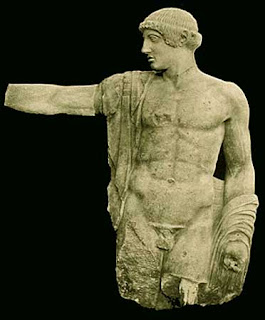Today is Monday July 2, 2012 by the western calendar. But it's also the day called 1 Rabbit in the year 13 Flint Knife, by the Mesoamerican Calendar.
Here's a diligent little rabbit scribe from an Aztec vessel (the so-called Princeton Vase for you trainspotters) to commemorate today, 1 Rabbit, the first day of the trecena called Rabbit, which is the last "month" (trecenas are 13 days long each) of the Mesoamerican calendar. Adorable, yeah? He's recording details of the ritual execution he's about to witness. Maybe that's why his eyes are bulging.
So, today's a big day for me because, after letting it sit and settle for four months, I've cracked open my novella again today, and I'm ready to finish it this month.
This will be my first book. I've never written anything of this length (110 pages or so right now, it'll be about 150 when it's done) and I'm happier with the rough draft than I've ever been with anything I've written.
So, I'm happy; I'm optimistic even. I'm going to finish the book this month, and print it. But I can't do it alone, and that's where I need my friends and family to step in.
I'm looking for people to help in two different ways: as readers and as investors.
I need readers. I went into the wilderness of my imagination and brought back some monstrosities. I'd like to turn them into literature. I need people who read a lot, or who have read a lot, or who would like to read a lot, to read my draft, and weigh in. I have a 100+ page draft on my hard drive right now. I'll email you a Word file of it, or if I like you a lot and you butter me up, I'll mail you a hard copy. This blog will become a private discussion board for my Readers. I'll expect you to get opinionated. I'm excited about friends of mine who would never meet otherwise getting their hands dirty in some literary debate. If you choose to be a reader, that's how you'll help me.
I should probably point out that I'm PARTICULARLY looking for readers who are familiar with ANY (or all) of the following: Burroughs, Camus, Borges, JG Ballard, Cormac McCarthy, HP Lovecraft, Raymond Chandler, the book of revelation, the qabalah (especially the Typhonian re-interpretation of it proposed by Kenneth Grant et al), the Popul Vuh, etc.
But I also need investors. I haven't made a final decision about exactly where I'm printing, but research makes me confident that I won't escape the process without spending at least $1000. I'm looking for 50 people to invest $20 each. In exchange for this, I'm offering a copy of the book, and your name on the dedications page.
Simple as that. Yes, you can be a reader AND an investor if you want.
This begins NOW and will be done by the end of the month, so email me NOW if you're interested. I'm starting the revisions tomorrow!
Thanks y'all,
croixclayton@juno.com












































